- This article is about the location in the series. For the location in the film, see Northern Water Tribe.
| "The Water Tribe is a great nation. There's a reason they've survived one hundred years of war. The frozen tundra is treacherous, the landscape itself is an icy fortress." |
| — Zhao to Captain Li.[1] |
The Northern Water Tribe is a division of the Water Tribe located within the realms of the North Pole. Its capital city, notable for being made almost entirely out of ice, is referred to by the same name. Built inside high walls of ice and surrounded by largely inhospitable tundra terrain, the city thrives in its isolation.[1] No attack by the Fire Nation on the city during the Hundred Year War ever succeeded, including the massive Siege of the North.[2] As such, the Northern Water Tribe maintained prosperity throughout the War, unlike its counterpart, the Southern Water Tribe, which lost all of its able-bodied men and all but one waterbender to the war efforts. After the fall of Ba Sing Se, the Northern Water Tribe was the only major city that had not fallen under Fire Nation control. The settlement continued to grow and develop following the end of the Hundred Year War, expanding to encompass regions above the cliffs that protect the tiered capital city.
History
Ancient times
Long before the Hundred Year War, the predecessors of the Water Tribe relocated to the North Pole from the tropical regions they originally inhabited.[3] There, they formed several independent tribes. Eventually, a group of waterbenders united to build the capital city of the Northern Water Tribe in an attempt to bring all the tribes of the North Pole together. The waterbenders used their icy environment to create the various temples, villages, and canals that comprise the city.[4] After a time of civil unrest, this newfound unity declined, and a group of secessionists journeyed to the South Pole to engender a new tribe.[5] Despite these initial difficulties, the relations between the Northern Water Tribe and the secessionist Southern Water Tribe improved over time. The New Moon Celebration was etablished in order to reunite the two Water Tribes. Around 345 BG[nb 1] Avatar Kuruk was born into the Northern Water Tribe.[7]
Hundred Year War
By early 100 AG, a large ice wall had been erected around the capital's entrance in order to protect the tribe from the Fire Nation.
Prior to the Hundred Year War, the Northern Water Tribe was an open port city that was accessible to any visitors. However, when the Fire Nation declared war on the Water Tribes, a thick wall of ice was erected at the mouth of the city as a means to keep the Fire Nation out of the Northern Water Tribe. When the War began, the Northern Water Tribe became increasingly isolated, cutting off most of its contact with the outside world and eventually losing touch with the Southern Water Tribe, leaving the battered tribe to fend on its own.
While the Northern Water Tribe did fall under attack from the Fire Nation, the attacks did not succeed as they did against the Southern Water Tribe. After a while, the attacks ceased entirely. The last time Northern warriors recovered Fire Nation uniforms was eighty-five years before Team Avatar's arrival, and Chief Arnook referred to an impending attack as the day feared for a very long time.[8]
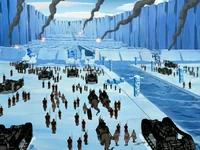
The Fire Nation besieged the city during the final stages of the Hundred Year War.
In the Siege of the North, the Northern Water Tribe was nearly destroyed when Admiral Zhao led a massive naval assault on the capital city in an attempt to destroy the Water Tribes and kill the Moon Spirit, Tui, in an attempt to eradicate waterbending. The tribe was saved when Avatar Aang, merged with the Ocean Spirit La, destroyed the Fire Navy fleet and when Princess Yue gave up her life to revive Tui, thus becoming Tui's successor.[2]
Prosperity and unification of the Water Tribes
In the aftermath of the Fire Nation's siege of the North Pole, select benders and healers from the Northern Tribe left for the South Pole in an effort to rebuild their ravaged sister tribe.[2] They succeeded, and eventually the governments of the two tribes were merged. The Southern Water Tribe became an autonomous confederation under jurisdiction of the Northern chief. At the same time, the Northern capital city began to grow significantly, becoming a large metropolis in the process.[9] The tribe went through a social reform as well, as women were no longer restricted by law.[10] After the foundation of the United Republic, the Northern Water Tribe was given a seat on the United Republic Council.[6] Many Northerners migrated into the republic in course of the following years, becoming a significant minority in Republic City.[11]
After undergoing a surgery to alter his physical appearance, Republic City's most notorious crime boss, Yakone, made his way to the Northern Water Tribe to start life anew. There, he married a woman and had two children, Noatak and Tarrlok. After Yakone forced his children to bloodbend each other, Noatak ran away. Yakone and Tarrlok assumed that Noatak had perished in the ice.[12] However, Noatak survived and made his way to Republic City, where he assumed the alias of "Amon", and started the Anti-bending Revolution in an attempt to rid the world of bending.
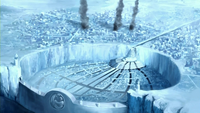
The large metropolis came under attack by barbarians in 151 AG.
By 151 AG, the tribe came under attack by a barbarian horde. Tonraq, general of the troops at the time, defended the city and expelled the invaders. However, by destroying a sacred spirit forest in his quest to apprehend the Barbarians, he brought the wrath of the spirits in the city, and the entities laid waste on the capital city. The metropolis was saved by his brother, Unalaq, though Tonraq was banished by their father, chief at that time. As a result, Unalaq took over his older brother's birthright, and became chief after their father.[9]
In 170 AG, Tarrlok served as the Northern Water Tribe's representative in the United Republic Council,[6] and was crucially involved in the Anti-bending Revolution. Later, he revealed Amon's history in the Northern Water Tribe to Avatar Korra and Mako.[12] Following Tarrlok's death, and the dissolution of the United Republic Council, the North lost its direct influence in the republic.[13]
Water Tribe Civil War
In 171 AG, under Unalaq's leadership, the Northern Water Tribe's Navy began an invasion of their sister tribe, ostensibly to protect the spirit portal at the heart of the South Pole and to prevent the South from falling into spiritual decay.[9] The occupation was not welcomed by the Southerners, who felt that Unalaq's actions threatened their sovereignty.[14] Eventually, these tensions boiled over when Team Avatar broke a group of rebels out of prison after learning that Unalaq had not only fixed their trial, but also organized the barbarian invasion of the North that led to Tonraq's banishment. This event officially ignited the Water Tribe Civil War.[15] Unalaq used the chaos of the conflict to prepare for the Harmonic Convergence during which he freed Vaatu and merged with the spirit. The Northern troops were eventually defeated and Unalaq killed, ending the civil war with the South's victory. Soon after, Avatar Korra declared the Southern Water Tribe independent from the North.[16]
Government
Government system: Unitary monarchic chiefdom
Head of State and Government: Chief
The Northern Tribe is a hereditary monarchy with its monarch called chief by tradition, though the modern government has abandoned many of the tribal aspects that dominated the tribe for centuries. The chief is commander-in-chief of the tribe's military and has almost autocratic authority over political affairs. However, he officially has no influence on judicial courts, though Chief Unalaq was able to control the courts by bribery.[15] The chief can order martial law and banish anyone as punishment for endangering the tribe.[9]
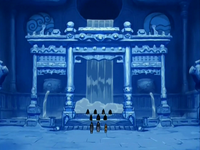
By 100 AG, a council that convened in the palace's throne room had great influence on the North's politics.
By the latter stages of the Hundred Year War, the tribal aspects were still strong: Even though the chief was powerful, politics were often personal and determined by the authority of individuals. Normally, the chief made decisions based on advice given by a small council of the respected individuals in the tribe. It was this council that was responsible for making laws and organizing the tribe. Political rise was driven more by the right connections and descent than by performance. Because of these politics, marrying the chief's daughter, the Tribal Princess, was considered to be a significant step in a person's political career. The Northern Water Tribe was infamous for upholding extreme sexist views before the end of the Hundred Year War; the tribe had a law that did not allow women to learn martial waterbending. Labor division was generally dependent on gender: men typically worked as hunters, fishermen, teachers, or warriors, and women usually served as homemakers, healers, or teachers.[5][8] These patriarchal and sexist traditions were abandoned after the Great War.[10] By 171 AG, it was not uncommon for the Tribal Princess to be a waterbending master and take an active role in times of war.[17]
Some time after the Hundred Year War, the governments of the Northern and Southern Tribe were merged, with the Northern chief becoming the official head of state of both tribes. As a result, the political power of the chief was great in the North, but limited to ceremonial and representative tasks in the South.[14][18] In times of crisis, however, the chief could dissolve the ruling Southern Council of Chieftains and Elders, assuming almost dictatorial power over the South in the process.[13] The Southern Water Tribe regained full independence after the civil war in 171 AG.[16]
Locations
City
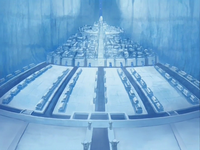
Northern Water Tribe.
Located at the North Pole, the Northern Water Tribe city is huge and multi-tiered, built into the icy landscape. Looming over the city are giant ice cliffs from which it was originally built. The city rests on the shores of the Northern Sea, and behind it is an enormous frozen tundra.[1]
Unlike the obliterated Air Nomads and their southern sister tribe, the Northern Water Tribe survived a century of war with the Fire Nation, due to the defenses their icy terrain provided. Resting on the shores of the Northern Sea, behind high walls of ice and an ice gate and canal lock system passable only by the use of waterbending, there lies a large and bustling monarchic nation-state. Ruled by a supreme chief, the capital city features a palace, an army, and many skilled warriors, healers, waterbenders, and a hidden oasis which houses Tui and La, the Moon and Ocean Spirits.
Powered by waterbending, gondolas are used to navigate the city's expansive system of canals. These interconnecting waterways play a crucial part in the tribe's defenses. Water-locking chambers act as the only entrances into the main city; boats travel through the gates, and, once the boats are in, waterbenders raise the water levels, lifting the boats until the vessel finally reaches the waterways of the Northern Water Tribe. This special entrance ensures that no unwanted ships can make it into the city. Because of these special security features and the city's location, the Northern Water Tribe was able to fend off numerous Fire Nation attacks.[4]
Armory
Located on the warrior training grounds, the Water Tribe armory is where Water Tribe weapons are stored and kept in pristine condition. The armory doubles as a war planning room where orders are given to the warriors. Some Fire Nation uniforms, which were captured about eighty five years prior, are also kept there.[8]
Chief's temple
The palace.
The Chief's temple is a large structure built on top the highest tier of the capital city and is one of the most recognizable landmarks. It can be seen from most anywhere in the city and stands like a monument, representing strength and power. In here, the chief and his advisers sit and make decisions regarding the tribe.[1][4]
The temple's design mimics that of a tiered pyramid. Leading up to the front entrance is a large staircase which is bordered on either side by a decorative pillar. A pool of water and a number of artificially designed waterfalls surround the building, giving it a unique ambiance; the liquid for this system is supplied by various pipelines that pour water into the pool from directly below the temple. During special events after nightfall, the interior of the temple is lit up, so that light shines through the front entrance and the central windows up to the top floor of the structure. When Team Avatar arrived at the Northern Water Tribe, a celebration was held near the Chief's temple.[1]
The interior of the building is intricately designed, featuring a decorative arch with four pillars, two cauldron-shaped ice sculptures, carvings of Water Tribe symbols, a rug adorned with the insignia of the nation, and an artificial waterfall behind the arch.[5]
Healing huts
The healing huts are small classroom-like structures. Here, Yugoda taught her young female students how to master their healing abilities using mannequins with human chi paths carved into them.[1]
Spirit Oasis
- Main article: Spirit Oasis
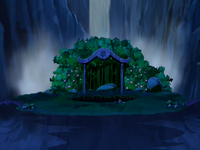
The Spirit Oasis.
The Spirit Oasis is a verdant and lush garden located in a cave in the Northern Water Tribe's capital city at the North Pole. Although the land outside is perpetually frozen, the Spirit Oasis itself is warm. This is where the mortal incarnations of the Moon and Ocean Spirits live. The water of the oasis is said to contain unique healing properties. It is a place where the Spirit World overlaps with the mortal world.[19] It is known to be one of the most peaceful places in the bending world.[8]
Underground ice cavern
These interconnecting ice caverns are located underneath the city and were naturally created by the ocean water eroding away the ice. Seals and other animals live in these ice caverns, and the only way to get to them is to swim through the freezing water.[5] Zuko traveled through these caverns when trying to capture Aang during the Siege of the North.[8]
Frozen tundra
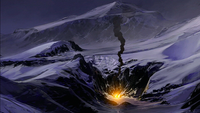
The frozen tundra of the North Pole.
This massive stretch of arctic tundra covers most of the North Pole. The inland tundra is mostly mountainous and inhabited by a diverse fauna. The valleys of the arctic mountain ranges also host small settlements, such as Yakone's village.[12]
However, the coastal arctic plains are extremely treacherous. Only highly skilled arctic hunters travel on the open plains, hunting the animals that live there, and they never stay longer than a few days at a time. Heavy winter blizzards constantly pelt the tundra, and unstable ice sheets often give way under the slightest pressure. Even experienced waterbenders and warriors think twice about venturing into this dangerous environment.[5]
Sacred spirit forest
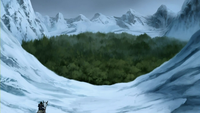
The spirit forest before it was destroyed by Tonraq and his men.
Deep in the tundra of the Northern Water Tribe lies a sacred forest, which many spirits called their home. During the barbarian invasion of the Northern Water Tribe, Tonraq and his men chased the barbarians into the forest. The barbarians thought they would be safe there, believing the Northern Watertribesmen would not dare to attack on holy grounds. Tonraq, however, had no such concerns, and subsequently attacked, destroying the forest in order to capture the barbarians.
Yakone's village
This village served as Yakone's new home after he left Republic City and assumed a new identity. Here, he met his wife and had two children, Noatak and Tarrlok. He lived out the remainder of his life in this village, teaching his children bloodbending until Noatak ran away and assumed his new identity as Amon.[12]
Culture
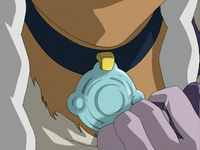
Princess Yue's betrothal necklace, given to her by Hahn.
Women become marriageable at the age of sixteen. Some marriages are arranged, with the bride in particular having no say in the matter. Engaged women wear "betrothal necklaces", navy blue chokers bearing blue stone pendants carved by their husband-to-be.[5] Until after the Hundred Year War, it was forbidden by custom for female waterbenders to learn waterbending for fighting purposes. Instead, they were trained as healers, able to use bending to heal wounds and at least some illnesses and mental disturbances.[1]
While the Southern Water Tribe seemed to have similar traditional roles, they were apparently much more strict in the North, as Katara, who was raised in the South, expressed surprise and anger when she was initially denied equal treatment in waterbending training.[1] As a result, it can be concluded that female waterbenders are allowed to learn waterbending for fighting purposes in the Southern Water Tribe. Kanna, Katara's paternal grandmother, Hakoda, Katara's father and Bato, a Southern Tribe male and a friend of Katara's father, also showed no signs of disapproval when observing Katara's waterbending skills; Southern female waterbenders once used their bending to attack Fire Nation soldiers.[20]
Education
Like the Fire Nation, Northern schools include subjects such as history, strategy, reading, writing, music, waterbending, and others. This is apprent due to the fact that the population has shown to know quite a lot about these subjects. The city also boasts numerous medical schools and science institutions that teach young female waterbenders to hone their healing abilities and medical skills. Northern schools and institutions teach other subjects, like geography; this is apparent from the fact that they can read maps.
Natural resources and foods
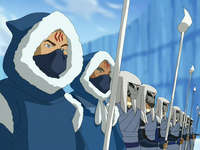
Northern Water Tribe warriors.
Inhabiting frozen poles near the seas, the Water Tribes inherently are dependent on the oceans for a majority of their natural resources as well as the bounty of the frozen tundra. Sea prunes are a favorite, while giant sea crabs are considered a delicious delicacy to those in the Northern Sea. Squid and seaweed can be used to make a wide variety of dishes, including soup, seasoning, and even bread and cookies.
Skins from seals are used to create tents, while pelts from polar bears and other furry animals are used as clothing and to cover barren surfaces. Naturally, hunters and fishermen of the Water Tribes are some of the best in the world in their field.
One of the most prevalent natural resources of the Northern Water Tribe is ice. Ice is used as the main building material used to make buildings, walls, dikes, locks, and other structures, as well as a medium of bending.
Notable figures
|
Fauna
Trivia
- Like its sister tribe in the south, the Northern Water Tribe has several villages outside the main city.[12]
- As part of his journey to master the elements, Avatar Roku met his waterbending teacher here and mastered waterbending.[21]
- By 151 AG, the Northern Water Tribe capital city had expanded to areas atop the cliffs that surround the city.
- The canal system in the city was inspired by the canals found specifically in Italy.[22] The design of the bridges connecting the two sides of each canal resemble that of Venice, and the architecture of most of the city is strikingly European.
- Even though the ice wall in the harbor of the city was constructed exclusively for the purpose of keeping the Fire Nation Army from entering the city, the wall was not taken down after the end of the Hundred Year War.
- Aang and Korra have both been reminded about their spiritual connection as the Avatar by individuals tied to the leadership in the Northern Water Tribe; Princess Yue reflected on the spiritual connection with Aang and Katara during the invasion of the North, and Korra was later told of and trained on her spiritual connection by Chief Unalaq.